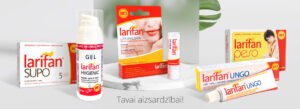HISTORY OF THE DEVELOPMENT OF LARIFAN FROM A SCIENTIFIC LABORATORY TO A COMMERCIAL DRUG
In the late 50s of the last century, interferon was discovered – an antiviral protein of mammals, which also has immunomodulatory and antitumor properties. Simultaneously with the development of interferon preparations suitable for clinical use, the search for interferon inducers capable of inducing the formation of this protein in the body also began. Among the many inducers, only a few were able to meet the requirements for medicines.
In the 70s at the Institute of Microbiology. August Kirhenstein of the Latvian Academy of Sciences began work on the search for interferon inducers among nucleic acids. The work was carried out under the guidance of the head of the laboratory G. Feldmane and the head of the laboratory V. Loža. A comparative study of several dsRNA (double-stranded RNA) production systems was carried out and the most productive was chosen. A continuous improvement in the production technology followed, and the physicochemical characteristics were determined. Along with the study of the biological properties and mechanism of action of dsRNA, a drug was created, called Larifan. A thorough preclinical study was carried out and several dosage forms of the drug were created.
At the stage of experimental studies, besides of studies at latvian research laboratories much of the work was carried out in Moscow at the Institute of Virology of the Academy of Medical Sciences, partly joined by the Institute of Influenza in Leningrad.
The Ministry of Defense of the USSR showed particular interest due to the fact that when screening available antiviral drugs suitable for bacteriological weapons, larifan was in first place.
In the 80s, preliminary clinical testing of the first dosage forms of the drug – an injection and an ointment – began, which was carried out in clinics in Latvia, as well as in other places of the Soviet Union. The Ministry of Health of the USSR allowed approbation since 1987, which was carried out at the Department of Skin Diseases and the Clinic of Skin Reparative Processes of the 1st Moscow Medical Institute, at the Department of Dermatology of the Kyiv Institute for Postgraduate Medical Education and in dermatological and venereal clinics in Lithuania and Latvia (at 13 different clinical bases).
By the decision of the specialized expert commission on antiviral drugs at the Pharmacological Committee dated 03/06/1991, the test results were approved and the drug was sent for registration to the USSR Pharmaceutical Committee. The results of tests in closed institutions of the Ministry of Defense were also taken into account. Registration ended due to the collapse of the USSR.
The registration process continued in Latvia. Ointment Larifana was registered in 1994, injection form – in 2004.
Both before registration and in the post-registration period, cooperation with scientific and medical institutions in Latvia and other countries (Estonia, Lithuania, Ukraine, Georgia, Armenia) continues and the results are reported at congresses and conferences.
In light of the threatening pandemic of influenza and other especially dangerous viral infections, in parallel with the intensive search for specific vaccines, the antiviral potential of Larifan should be seriously weighed. It is known that the human influenza virus is sensitive to Larifan, and the viral component of the avian influenza virus turned out to be sensitive to the synthetic analogue of Larifan, Ampligen (US data). The use of antiviral drugs, which are also immunomodulators, outlines a new promising approach to the treatment of severe viral infections in the world.
In the context of the current Covid-19 pandemic, also in parallel with the intensive search for specific vaccines, the antiviral potential of Larifan should be weighed especially seriously, which is also done in the European Medicines Agency (EMA).
At present, the active substance, dsRNA, is produced at Larifan LLC in Riga.
